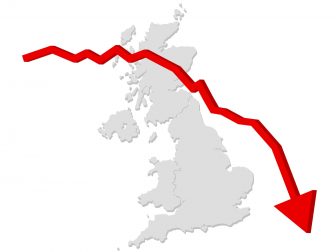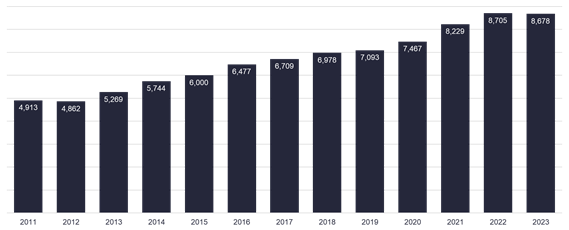 The total value of all homes across the UK now stands at £8.678trn, according to new research by property firm Savills.
The total value of all homes across the UK now stands at £8.678trn, according to new research by property firm Savills.
The analysis of the UK’s housing stock reveals that the total value has fallen marginally on 2022 – when values peaked – but remains £1.585trn higher than before the pandemic (2019).
“Despite higher mortgage costs, the market’s resilience means UK housing continues to be a significant, and a relatively secure, store of wealth. Even after deducting outstanding mortgage debt of £1.652trn, our figures show that net housing wealth continued to exceed £7trn; a figure 2.6 times the size of the UK’s economy,” commented Lucian Cook, head of residential research at Savills.
“In 2023 the total value was supported by an £80 billion uplift from new housing delivery. But, more fundamentally, the market was insulated from interest rate pressures by a combination of more stringent mortgage regulation, the increased use of fixed rate mortgages and the assistance provided by lenders to those in financial difficulty.
“We may see the cost of mortgages ebb and flow over the course of 2024, as markets respond to changing expectations of when and how much the Bank of England will cut the base rate. But over the medium term we expect affordability pressure to ease, meaning that the recent loss in value should be short lived.”
Table 1: Total value of UK housing (£bn)
Source: Savills Research
NB historic data has been revised slightly in light of the release of more detailed census information
Regional differences
According to Savills, the value falls, though relatively benign, were concentrated in the south. The total value of London’s housing stock decreased by -£39.3 billion (-2.1%), while the South East, South West and East of England saw a combined -£16.5 billion (-0.5%) fall.
By contrast, markets further from London which have a greater capacity for growth, saw values increase on the year. The most significant uplift was in Northern Ireland (3.2%), North East (1.4%), Scotland (1.3%) and the East Midlands (1.3%).
Regional values and changes (£bn)
| Total value in 2023 | 1 year change (v 2022) | Since 2019 | |
| London | 1,825 | -39.3 | 206.5 |
| South East | 1,630 | -6.1 | 297.3 |
| East of England | 975 | -6.4 | 170.8 |
| South West | 845 | -4.0 | 184.7 |
| North West | 680 | 3.0 | 149.8 |
| West Midlands | 607 | 5.2 | 125.7 |
| East Midlands | 514 | 6.5 | 118.3 |
| Yorkshire & the Humber | 489 | 3.8 | 102.1 |
| Scotland | 481 | 6.2 | 97.7 |
| Wales | 299 | -2.8 | 64.5 |
| North East | 186 | 2.5 | 33.6 |
| Northern Ireland | 147 | 4.6 | 33.5 |
| United Kingdom | 8,678 | -26.7 | 1,584.6 |
Source: Savills Research
While London accounts for the largest proportion of the total value of UK housing, since 2016 it has only accounted for 12.01% of total growth. As a result, its proportion of the total value of UK housing has fallen from a high of 24% (in 2016) to a more normal 21% in 2023.
“A geographical rebalancing of the UK housing market continued in 2023,” continues Cook. “As expected at this stage in the cycle, the most robust regional markets were those where mortgaged buyers had to borrow less in relation to their income.”
Outright homeowners biggest beneficiaries of growth
Outright owner occupiers continue to be the major beneficiaries of value growth. According to Savills, homes owned outright now account for almost 40% of the total value of all UK housing.
The analysis shows that the value of property held by mortgage-free owner occupiers has increased by £1.505 trillion (£1,505 billion) over the past decade, while that held by mortgaged owner occupiers has risen by a lesser £978 billion.
“Back in 2013 the value of housing held by unmortgaged and mortgaged owner occupiers was very similar. However, demographic changes and a shift in access to home ownership have substantially widened the gap between the two in the last 10 years,” says Cook.
“We continued to see people who benefitted from the homeownership boom of the latter part of the 20th century joining the ranks of the mortgage-free in 2023. But at the same time, aspiring homeowners had to contend with a combination of high deposit requirements and increased mortgage costs last year.
“Meanwhile increased taxation and regulation have constrained supply in the private rented sector housing, despite rising tenant demand,” concludes Cook.
Total of UK Housing Stock by Tenure £bn
| Total stock | Total Value in 2023 | 5 year change | 10 year change | |
| Owned Outright | 9,588,705 | 3,383 | +790 | +1,505 |
| Mortgaged Owner Occupied | 8,441,118 | 2,836 | +473 | +978 |
| Private Rented | 5,774,303 | 1,591 | +306 | +682 |
| Social rented* | 5,323,132 | 507 | +39 | +98 |
| Other | 1,202,349 | 360 | +91 | +145 |
| Total | 30,329,607 | 8,678 | +1,700 | +3,408 |
Source: Savills Research *valued on an investment basis having regards to tenants’ occupational rights



Comments are closed.